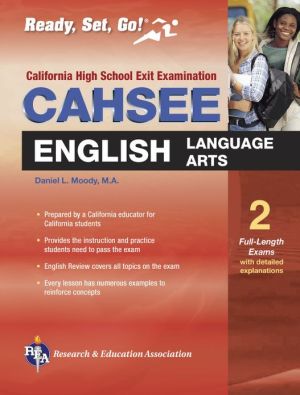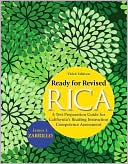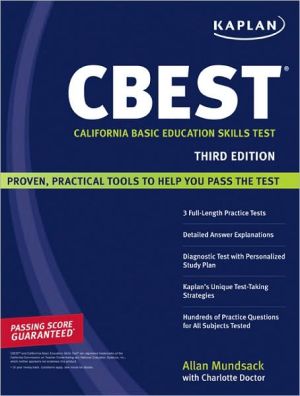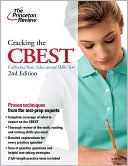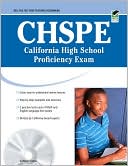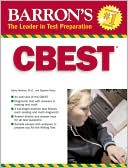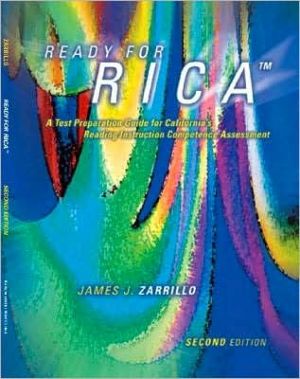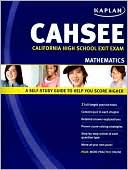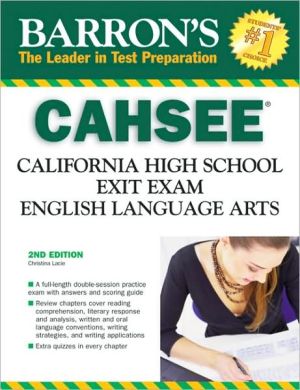CAHSEE English-Language Arts: The Best Test Prep for the California High School Exit Examination in Language Arts
REA Real review, Real practice, Real results.\ \ REA's California CAHSEE English Language Arts Study Guide!\ Fully aligned with California’s core curriculum standards\ \ Are you prepared to excel on this state high-stakes assessment exam? \ * Passing the exam is required to receive a high school diploma\ * Find out what you know and what you should know\ * Use REA's advice and tips to ready yourself for proper study and practice\ \ Sharpen your knowledge and skills\ *...
Search in google:
REA … Real review, Real practice, Real results. REA's California CAHSEE English Language Arts Study Guide!Fully aligned with California’s core curriculum standards Are you prepared to excel on this state high-stakes assessment exam? * Passing the exam is required to receive a high school diploma* Find out what you know and what you should know* Use REA's advice and tips to ready yourself for proper study and practice Sharpen your knowledge and skills* The book's full subject review refreshes knowledge and covers all topics on the official exam, including vocabulary, reading comprehension literary analysis, drafting and revising, and skill-building exercises to reinforce key English language lessons* Smart and friendly lessons reinforce necessary skills* Key tutorials enhance specific abilities needed on the test* Targeted drills increase comprehension and help organize study* Color icons and graphics highlight important concepts and tasks Practice for real* Create the closest experience to test-day conditions with two full-length practice tests* Chart your progress with detailed explanations of each answer* Boost confidence with test-taking strategies and focused drills Ideal for Classroom, Family, or Solo Test Preparation! REA has helped generations of students study smart and excel on the important tests. REA’s study guides for state-required exams are teacher-recommended and written by experts who have mastered the test.
Passing the CAHSEE: English-Language Arts\ About this Book This book will provide you with an accurate and complete representation of the English-Language Arts section of the California High School Exit Examination (CAHSEE). Inside you will find reviews that are designed to provide you with the information and strategies needed to do well on the test. Two practice tests are provided, both of which are based on the official CAHSEE. The practice tests contain every type of question that you can expect to encounter on the CAHSEE English-Language Arts. Following each test, you will find an answer key with detailed explanations designed to help you completely understand the test material.\ About the Test\ Who Takes the Test and What is it Used For?\ Beginning with the class of 2006, every high school student who plans to graduate from a California public high school must first pass the California High School Exit Examination (CAHSEE). The test consists of two parts: Mathematics and English-Language Arts.\ Students are first required to take the CAHSEE in grade 10. Those who pass both parts, Mathematics and English-Language Arts, have completed the test requirement for graduation and do not have to retake the test. Students who do not pass either or both parts need to retake the part or parts they have not passed in 11th grade and 12th grade, until they pass.\ When and Where Is the Test Given?\ Every public school district in California will provide students with multiple opportunities to take the CAHSEE. Each district may administer the CAHSEE several times a year, choosing from a list of test dates that are designated by the State Superintendent of Public Instruction.\ The CAHSEE test is administered over two days. The English-Language Arts section is given on the first day followed by the Mathematics portion the next day.\ Is There a Registration Fee?\ No. Because all California public high school students are required to take and pass this test in order to receive a high school diploma, no fee is required.\ Test Accommodations and Special Situations Parents of special education students, students with disabilities (including attention deficit disorder), and students who are learning English should contact their local high school officials regarding possible waivers, extra time, or special arrangements (accommodations or modifications) during the CAHSEE. These special arrangements can include the use of a calculator, special seating, a quiet environment, or a large print test booklet, among others. English learners may be able to use a glossary.\ Scoring of the test may be done differently, depending on whether the special arrangement is an accommodation or a modification. Ask your school officials for further information or check on the CAHSEE website.\ Additional Information and Support Additional resources to help you prepare to take the CAHSEE include:\ * the official State of California CAHSEE website at http://www.cde.ca.gov/ta/tg/hs/resources.asp\ * REA's The Best Test Preparation for the CAHSEE Mathematics\ How to Use this Book\ What Do I Study First?\ Read over the review sections and the suggestions for test-taking. Studying the review sections thoroughly will reinforce the basic skills you need to do well on the test. Be sure to take the practice tests to become familiar with the format and procedures involved with taking the actual CAHSEE.\ To best utilize your study time, follow our CAHSEE Independent Study Schedule located on page xix of this book.\ When Should I Start Studying?\ It is never too early to start studying for the CAHSEE. The earlier you begin, the more time you will have to sharpen your skills. Do not procrastinate! Cramming is not an effective way to study, since it does not allow you the time needed to learn the test material. The sooner you learn the format of the exam, the more time you will have to familiarize yourself with the exam content.\ Format of the CAHSEE: English-Language Arts Overview of the English Language Arts Portion of the CAHSEE The English-Language Arts portion of the CAHSEE is designed to test students' ability to read and write, knowledge of basic literary concepts, and familiarity with basic writing strategies. Each exam has 72 multiple-choice questions and one essay. In addition, there are seven multiple-choice questions that are not scored; they are just being tried out for future tests.\ Types of Questions There are a total of 45 multiple-choice questions that test reading ability. These fall into the following categories:\ * Word Analysis—7 Questions\ * Reading Comprehension—18 Questions\ * Literary Response and Analysis—20 Questions There are a total of 27 multiple-choice questions that test writing ability. These questions are divided as follows:\ * Writing Strategies—12 Questions\ * Written English Language Conventions—15 Questions Students must also write one essay, assigned at random from five possible essay types.\ Scoring the Practice Tests These practice tests cannot determine what exact score you would receive when taking the actual CAHSEE, but they can help you find out if you are improving. To pass the English-Language Arts portion of the CAHSEE you need to receive approximately 60% of the possible points.\ To get a rough estimate of the percentage correct on each of the two practice tests in this book, follow this procedure:\ 1. Determine the approximate score (1-4) on the writing sample by asking several people to compare it with the sample essays in the "Detailed Explanations of Answers" section that follows each practice test. _____________\ 2. Multiply by 4.5. ____________ ´ 4.5 = ____________\ This number shows the approximate number of points you would receive for the essay.\ 3. Determine the number of correct answers on the rest of the test. _____________\ 4. Add the number of correct answers to the number of points for the essay to find the total points. _____________ + _____________ = _____________\ 5. Divide the total points by 90 to get an approximate percentage of points correct.\ _____________ / 90 = _____________\ Test-Taking Strategies What to Do Before the Test\ * Pay attention in class.\ * Carefully work through the review sections of this book. Mark any topics that you find difficult so that you can focus on them while studying and get extra help if necessary.\ * Take the practice tests and become familiar with the format of the CAHSEE. When you are practicing, simulate the conditions under which you will be taking the actual test. Stay calm and pace yourself. After simulating the test only a couple of times, you will feel more confident, and this will boost your chances of doing well.\ * Students who have difficulty concentrating or taking tests in general may have severe test anxiety. Tell your parents, a teacher, a counselor, the school nurse, or a school psychologist well in advance of the test. They may be able to suggest some useful strategies to help you feel more relaxed so that you can do your best on the test.\ What to Do During the Test\ * Read all of the possible answers. Just because you think you have found the correct response, do not automatically assume that it is the best answer. Read through each answer choice to be sure that you are not making a mistake by jumping to conclusions.\ * Use the process of elimination. Go through each answer to a question and eliminate as many of the answer choices as possible. By eliminating two answer choices, you will give yourself a better chance of getting the item correct since there will only be two choices left to choose from.\ * Work quickly and steadily and avoid focusing on any one question for too long. Taking the practice tests in this book will help you learn to budget your time on the actual test.\ * Work on the easiest questions first. If you find yourself working too long on one question, make a mark next to it on your test booklet and continue. After you have answered all of the questions that you know, go back to the ones that you skipped.\ * Be sure that the answer oval you are marking corresponds to the number of the question in the test booklet. Since the multiple-choice sections are graded by machine, marking one wrong answer can throw off your answer key and your score. Be extremely careful.\ * Work from the answer choices. You can use a multiple-choice format to your advantage by working backwards from the answer choices to answer the question. You may be able to make an educated guess based on eliminating choices that you know do not fit the question.\ The Day of the Test On the day of the test, you should wake up early after a decent night's rest and have a good breakfast. Make sure to dress comfortably, so that you are not distracted by being too hot or too cold while taking the test, and give yourself enough time to arrive at your school early. This will allow you to collect your thoughts and relax before the test.
ContentsSection 1 : Introduction Passing the CAHSEE: English-Language Arts About this Book About the Test How to Use this Book Format of the CAHSEE: English-Language Arts Scoring the Practice Tests Test-Taking Strategies CAHSEE Independent Study Schedule Section 2 : Reading Skills Chapter 1: Vocabulary Vocabulary Development Tools Using a Dictionary Making a Word List Practicing with Flashcards Root Words Understanding Vocabulary from Context Figurative Language Idiomatic Expressions Similes and Metaphors Synonyms and Antonyms Commonly Confused Words Chapter 2 : Reading Comprehension General Strategies Schedule Time to Read Keep a Reading List and a Reading Log Specific Reading Skills Identifying the Theme or Main Idea Selecting the Best Summary Discovering Meaning from Context Understanding Connotations Finding Information by Skimming and Scanning Chapter 3 : Analysis of Readings Analyzing the Purpose of a Reading (or AuthorÕs Purpose) Wording of CAHSEE Questions and Answers Analyzing Attitude, Tone, and Mood AuthorÕs Attitude Mood and Tone Analyzing Plot, Conflict, and Resolution Analyzing a CharacterÕs Personality, Feelings, and Relationships Definition of Character Simple or Complex Environment, Background, and Motivation Relationships and Interactions Between Characters Tips for Answering Questions about Character Identifying Literary Devices Setting Imagery Symbolism Allegory Dialogue, Soliloquy, and Asides Fact and Opinion Statistics Repetition Identifying Types of Literature (Genres) Plays Poetry Fiction Nonfiction Analyzing and Evaluating Supporting Information Evaluating Paragraph Unity Section 3: Writing Skills Chapter 4: Writing Strategies Using Specific Details and Language Using the Active Voice Sentence Combining Paraphrasing and Summarizing Chapter 5: Recognizing and Writing Correct Sentences Identifying Subjects and Verbs Definitions of Clause, Phrase, and Sentence Types of Sentences Simple Sentences Basic Compound Sentences Basic Complex Sentences Advanced Compound Sentences Complex Sentences with Relative Clauses Avoiding Common Sentence Errors: Fragments, Run-on Sentences, and Comma Splices Fragments Run-On Sentences Comma Splices Summary of Sentence Punctuation Sentence Patterns More About Sentences Phrases Placement of Modifiers Parallel Structure Chapter 6: Grammar and Usage Verb Tense Verb Forms that Show Past Time Verb Forms that Show Present Time Verb Forms that Show Future Time Subject and Verb Agreement Most Verbs Modal Verbs The Verb "To Be" Adjectives and Adverbs Introduction to Descriptive Adjectives Introduction to Adverbs Comparative Adjectives and Adverbs Superlative Adjectives and Adverbs Participial Adjectives Pronouns Definition of Pronouns Personal Pronouns Indefinite Pronouns Chapter 7: Punctuation and Capitalization Titles of Publications Books and Other Complete Works Articles, Chapters, Poems, Songs, etc. Quotation Marks Reporting Exact Words Apostrophes Apostrophes with Contractions Apostrophes with Possessives Special Uses of Apostrophes Commas Commas with Sentence Connectors Commas with Extra Information Commas with Introductory Elements Commas with items in a Series Commas in Certain Special Cases Semicolons To Join Clauses Together To Separate Parts of a Sentence Colons Using Colons to Introduce a List Using a Colon to Introduce a Quotation Using a Colon to Introduce an Explanation Dashes Ellipses Capitalization The First Word of a Sentence The Pronoun "I" Proper Nouns Section 4: Essay Writing Chapter 8: The Steps of the Writing Process Outline of Instructions for Writing an Essay Step-by-Step Instructions for Writing an Essay Understanding the Assigned Topic Prewriting Writing Revising Chapter 9: Essay Structure The Introduction Introductory Sentences Thesis Statement (Main Idea Statement) Body Paragraphs Key Points Support for Key Points Transitions Transitions Between Paragraphs Interesting Details and Specific Language The Conclusion Unity and Clarity Chapter 10: Types of Essays Response to Literature General Tips Possible Response to Literature Essay Topics Analytical Essay (Expository Writing) General Tips Actual CAHSEE Analytical Essay Topic Informational Essay (Expository Writing) General Tips Example Informational Essay Assignments Persuasive Composition General Tips Actual CAHSEE Persuasive Essay Topic Biographical Narrative General Tips Example Biographical Essay Assignments Business Letter Types and Purposes of Business Letters General Tips Example Business Letter Assignments Practice Test Answer Key Detailed Explanations of Answers Practice Test Answer Key Detailed Explanations of Answers Appendix: CAHSEE Scoring Guides Answer Sheets Index
